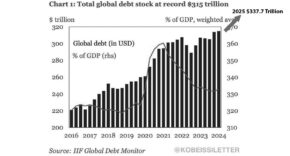The Enormous Scale of U.S.-EU Trade
Trade between the United States and the European Union is the largest and most complex bilateral trading relationship in the world. In 2024, the U.S. imported roughly $606 billion in goods from the EU and exported $370 billion in return. Add in services, and the total volume of trade between the two sides reached a stunning €1.6 trillion, or about $1.7 trillion.
That trade relationship supports millions of jobs and touches nearly every sector of both economies. According to the European Commission, “The transatlantic trade relationship is the most important commercial relationship in the world.” On average, €4.4 billion worth of goods and services move across the Atlantic each day.
But now that relationship is being tested by President Trump’s latest round of tariff threats, aimed directly at European imports. Trump’s decision to impose 30 percent tariffs on goods from the European Union starting August 1 has sent shockwaves through both governments and global markets.
What’s Behind Trump’s Tariff Strategy
President Trump’s team announced the tariffs in early July, raising the current 10 percent duties to 30 percent. These tariffs will apply broadly to European goods unless a new agreement is reached. In public statements, Trump has been clear about his goals. He wants to reduce the U.S. trade deficit, support domestic manufacturing, and force the EU to lower its own barriers.
Trump’s letter to European leaders was not filled with diplomacy. “They’ve protected their industries with tariffs and quotas for decades,” he said. “We’re simply leveling the playing field.” He has previously described the EU as “nastier than China” when it comes to trade practices, which suggests this conflict has been building for some time.
Supporters of Trump’s move argue that these tariffs are not the beginning of a trade war, but a negotiation tactic. They believe that Europe has long benefited from access to the U.S. market without giving enough in return. They point to Europe’s restrictive rules, agricultural standards, and preference for domestic suppliers as signs of protectionism.
What the U.S. Buys From Europe
European exports to the U.S. include a wide range of high-value products, many of which are highly sensitive to tariffs. The single largest category is pharmaceuticals, totaling $127 billion in 2024. European companies like Bayer, Novartis, and Sanofi play a major role, but U.S. pharmaceutical firms also operate factories in Europe, especially in low-tax Ireland.
Cars are another major import. The U.S. bought more than $45 billion worth of vehicles from Europe last year. Add in machinery, wine, perfume, and even luxury fashion items, and the picture becomes clear: Europe’s exports to America represent some of the continent’s most valuable and politically sensitive industries.
A tariff of 30 percent on these products could have serious consequences for European manufacturers, especially if American buyers reduce purchases or shift supply chains elsewhere.
What the U.S. Sells to Europe
While Europe enjoys a trade surplus in goods, the United States has strength in energy, aerospace, and services. U.S. companies exported $32 billion in aircraft and parts to the EU in 2024, along with over $12 billion in vehicles. Many of those vehicles are actually European brands like BMW and Mercedes, built in American factories for export back to Europe.
The U.S. also exported $5.2 billion in blood plasma and immunological products, and over $50 billion in crude oil and natural gas. Europe depends heavily on these energy supplies, especially after the crisis in Ukraine.
When services like consulting, finance, software, and technology are included, the U.S. runs a services trade surplus with the EU. According to the Bureau of Economic Analysis, the U.S. exported $277 billion in services to the EU in 2024 while importing $201 billion. Services are harder to count than physical goods, but they are a major part of the modern trade economy.
The EU’s Response: Holding Back But Ready
European leaders have not rushed to retaliate. Instead, they are waiting to see if a deal can still be made. The EU has already prepared €21 billion in counter-tariffs, with a second list of retaliatory duties targeting an additional €72 billion worth of U.S. goods. But so far, they have not triggered them.
Maros Sefcovic, the EU’s chief trade negotiator, said that Trump’s latest move was a surprise. “The feeling on our side was that we are very close to an agreement,” he said. “I spoke with my American counterparts almost every other day last week.” But then, just before the tariff announcement, he received a “heads up,” which “created a totally different dynamic.”
Still, Sefcovic said he would continue negotiating. “We feel the huge responsibility for the biggest trading relationship on this planet,” he said. “I cannot imagine walking away without genuine effort.”
Danish Foreign Minister Lars Lokke Rasmussen voiced similar concerns. “We do not want any kind of trade war,” he said. “It will be devastating, not just for the Americans, but also for Europe.” Yet he also warned that Europe must be ready to respond. “It’s a clear signal that we don’t want to escalate things. But we need to flash some muscles if needed.”
What Europe Might Offer
Negotiators still have options. The EU could offer to increase purchases of American goods such as soybeans, natural gas, or even military equipment, especially as European countries ramp up defense spending. They could lower tariffs on U.S. cars or ease quality regulations that currently block American agricultural products.
Alternatively, the EU could take a harder line. It might restrict exports of sensitive goods like medicine or impose new regulations on U.S. tech firms. This would be a risky move and could push the trade conflict into a full-scale war.
Despite the public tension, many analysts believe a deal is still possible before the August 1 deadline. One expected outcome could be a universal 10 percent tariff, with some industries facing rates of 20 to 25 percent. This would bring the effective rate to around 20 percent, lower than the headline figure and potentially acceptable to both sides.
But even if a deal is made, it may not be the end. “Trade deals are not written on one or two pages,” one analyst noted. “They usually take months or even years.” In today’s unpredictable trade landscape, no agreement can be considered permanent.
The next few weeks will be critical. As one European economist put it, “The latest letter was not a love letter, but also not a hate letter. It was a pressure tactic.”
FAM Editor: Trump is an expert at negotiation, and knows when to apply pressure even when it may not be “polite.” The EU is used to being the big dog on the block and not having to accommodate trading partners, they need the push.
Keep in mind that this move actually does the EU negotiators a favor. As voters in the EU become unhappy when certain trade barriers come down, the negotiators can point to “crazy Trump” as the excuse and it gets them off the hook.





